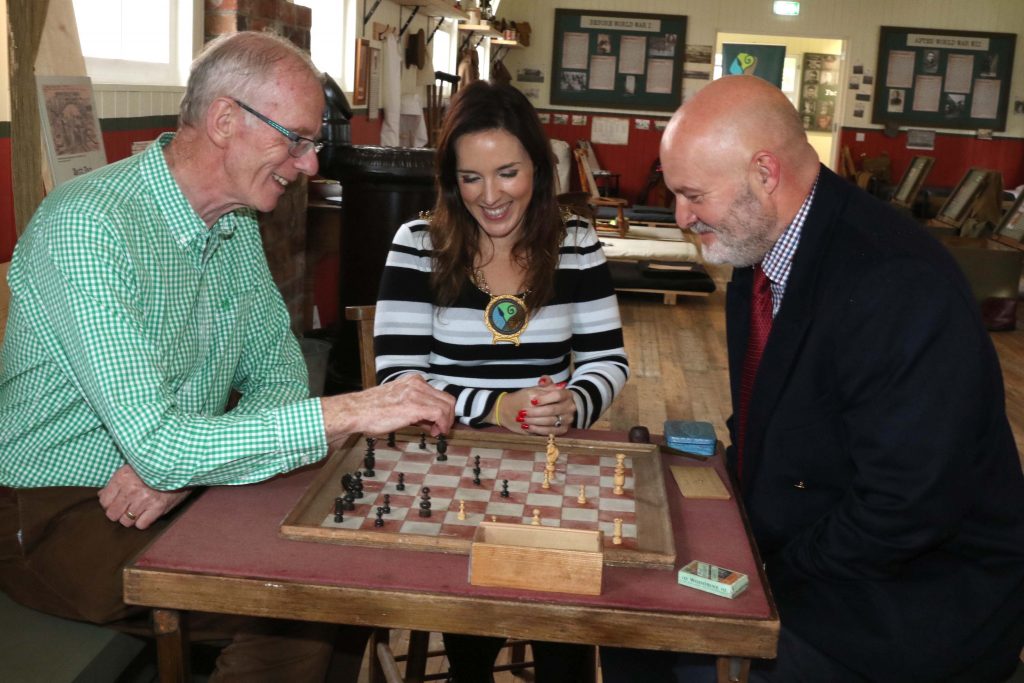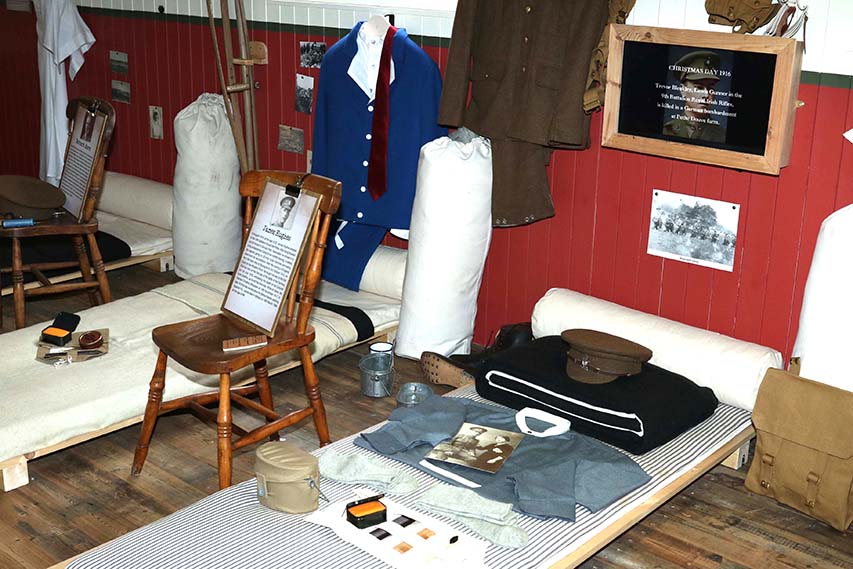Council Chairperson Launches Ballykinlar History Hut Experience at Down County Museum
An exciting new chapter of history about Ballykinlar camp will be open to the public to enjoy at Down County Museum from Wednesday 20th October. The Armstrong huts now demolished at Ballykinlar army camp played a key part in housing prisoners and military personnel in the 20th century.
A recreated Armstrong hut (complete with tunnel entrance) was constructed and fitted out during the Covid-19 lockdown period as part of Newry Mourne and Down District Council’s ‘Shared History and Culture’ programme, a project supported by the European Union’s PEACE IV Programme, managed by the Special EU Programmes Body (SEUPB). Match funding for this project has been provided by The Executive Office in Northern Ireland and the Department for Rural and Community Development in Ireland.

Newry Mourne and Down District Council Chairperson, Councillor Cathy Mason has formally opened the newly completed recreation of a First World War era Armstrong Hut from Ballykinlar Camp. Cllr Mason welcomed guests, including representatives from the Special EU Programmes Body (SEUPB) and those with a historic connection to the Hut, to the event at Down County Museum on Tuesday 19 October.
Attending the opening ceremony were two guests who had a connection with the huts from the last century. Tony Canniford Major (Retired), former Commandant (Senior Training Safety Officer), was stationed at Ballykinlar and takes a great interest in the shared history of the camp.
Tony retired in June 2021 after 43 years’ service. He assisted Down County Museum with the hut project in 2012, rescuing hundreds of items from under one of the last Armstrong huts to be dismantled at the camp. Some of the items are now on display at the museum.

Dr Paddy Moore whose grandfather, also Dr Patrick Moore, was interned in one of the huts at Ballykinlar in 1921, after standing as a Sinn Fein candidate in a local election also joined Tony Canniford as a guest at the opening of the Ballykinlar hut. Patrick looked after internees in the camp hospital and almost escaped through a 100-yard tunnel from his hut in July 1921, but the tunnel was discovered at the last minute. Both invited guests highlight the diverse and shared history of Ballykinlar Camp from 1914 to 1967.
Newry Mourne and Down District Council Chairperson, Councillor Cathy Mason extended her gratitude to the all the people who have shared their stories about the hut. She said: “Not only have the diverse stories of extraordinary men and women been told inside the Ballykinlar History Hut, but I am sure they will be of interest to people all over the world including citizens from the USA, Germany, Malta, Hungary and Belgium.
“The hut will be an important new tourist destination for the district. I would like to thank the Special EU Programmes Body for funding the Council’s shared history initiative through its PEACE IV Programme, and also all the people who have contributed stories and artefacts to tell the story of this historic place.”

The Chairperson of the PEACE IV Partnership, Martina Byrne speaking at the launch, and said: “Down County Museum has set out a unique shared history experience in the re-created hut, exploring the lives of diverse occupants of the ‘World’s End Camp’, and in particular those people who lived through the difficult years of the First World War, The Irish War of Independence and the Second World War. When you enter the hut, you really feel as if you are travelling back in time.”
Council staff have been working on the hut recreation for three years, assisted by the Centre for Data Digitisation and Analysis at Queen’s University Belfast, and have gathered about personal 100 stories of people who occupied the Armstrong huts.
The huts were first built to house 4000 Belfast men training with the 36th (Ulster) Division for active service on the Western Front in World War I, including at the Battle of the Somme in July 1916.

“Later the huts housed 1800 republican internees who were arrested all over Ireland during the Irish War of Independence in late 1920 and 1921. The soldiers in 1914 and the internees in 1921 were given the same beds, made from 3 planks, with 4 army blankets, to sleep on.
The original 60ft by 20ft timber huts, clad with corrugated iron, housed evacuees from Malta, American GIs and German prisoners of war during World War Two, and also sheltered Hungarian refugees in 1957, after the Russian invasion of Hungary.

Tony Canniford, a Major (Retired), and former Commandant (Senior Training Safety Officer), was stationed in one of the Ballykinlar huts during the 1980s for 10 years as a soldier and an Officers. He said that there were four huts left and “two were marked for Down County Museum and two for the Somme Centre. Many of the artefacts exhibited in Downpatrick were found under the floor boards of the huts that were demolished.
“Other items have come from families and the team researching the history of Ballykinlar Camp. The history looks at the periods of the two World Wars, the intervening War of Independence in Ireland, back to the Boar War, the Vikings and early settlers in Ireland.
“There is a fascinating history at Ballykinlar camp. For example, the evolution of trench warfare can be found there. The trenches used to train during the Boer War are still visible.”
The last huts were dismantled in 2012, when local man Andrew Carlisle recorded how one hut was built and saved hundreds of artefacts from the sand underneath, for a donation to Down County Museum.

Philip Orr’s book, published by the Museum, ‘Ballykinlar Camp, The First 70 Years’, was an inspiration to staff to recreate an Armstrong hut in the Museum’s courtyard, in order to tell the human stories of its many occupants, engaging world-wide with families of soldiers, prisoners, evacuees and refugees formerly at the World’s End Camp. The circular visit to the hut includes sections on ‘World War One’, ‘Internment’, ‘Between the Wars’ and the ‘World War Two’, with recreated beds and sets, each with a story to tell.
The Ballykinlar History Hut will be open for visits in the central courtyard at Down County Museum from Wednesday 27 October.
The Museum is currently open Wednesday to Saturday, 10am to 4.30pm. Admission is free of charge. For further information please visit:
Notes
- The Special EU Programmes Body is a North/South Implementation Body sponsored by the Department of Finance in Northern Ireland and the Department of Public Expenditure and Reform in Ireland.
- It is responsible for managing two EU Structural Funds Programmes, PEACE IV and INTERREG VA which are designed to enhance cross-border co-operation, promote reconciliation and create a more peaceful and prosperous society.
- The Programmes operate within a clearly defined area including Northern Ireland, the Border Region of Ireland and in the case of INTERREG VA, Western Scotland.
- The PEACE IV Programme has a value of €270 million and aims to promote peace and reconciliation in Northern Ireland and the Border Region of Ireland.
- For more information on the SEUPB please visit: www.seupb.eu

























